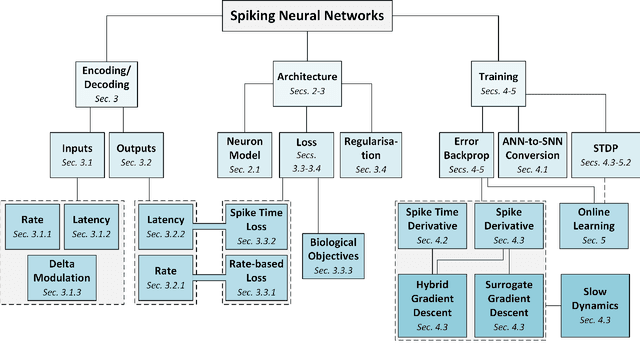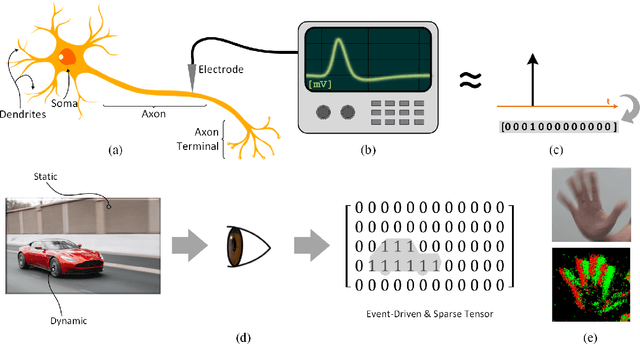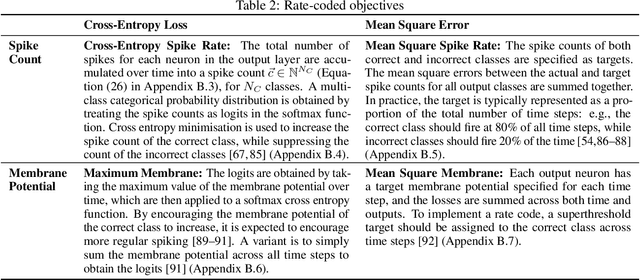Wei D. Lu
University of Michigan
Bulk-Switching Memristor-based Compute-In-Memory Module for Deep Neural Network Training
May 23, 2023Abstract:The need for deep neural network (DNN) models with higher performance and better functionality leads to the proliferation of very large models. Model training, however, requires intensive computation time and energy. Memristor-based compute-in-memory (CIM) modules can perform vector-matrix multiplication (VMM) in situ and in parallel, and have shown great promises in DNN inference applications. However, CIM-based model training faces challenges due to non-linear weight updates, device variations, and low-precision in analog computing circuits. In this work, we experimentally implement a mixed-precision training scheme to mitigate these effects using a bulk-switching memristor CIM module. Lowprecision CIM modules are used to accelerate the expensive VMM operations, with high precision weight updates accumulated in digital units. Memristor devices are only changed when the accumulated weight update value exceeds a pre-defined threshold. The proposed scheme is implemented with a system-on-chip (SoC) of fully integrated analog CIM modules and digital sub-systems, showing fast convergence of LeNet training to 97.73%. The efficacy of training larger models is evaluated using realistic hardware parameters and shows that that analog CIM modules can enable efficient mix-precision DNN training with accuracy comparable to full-precision software trained models. Additionally, models trained on chip are inherently robust to hardware variations, allowing direct mapping to CIM inference chips without additional re-training.
PowerGAN: A Machine Learning Approach for Power Side-Channel Attack on Compute-in-Memory Accelerators
Apr 13, 2023Abstract:Analog compute-in-memory (CIM) accelerators are becoming increasingly popular for deep neural network (DNN) inference due to their energy efficiency and in-situ vector-matrix multiplication (VMM) capabilities. However, as the use of DNNs expands, protecting user input privacy has become increasingly important. In this paper, we identify a security vulnerability wherein an adversary can reconstruct the user's private input data from a power side-channel attack, under proper data acquisition and pre-processing, even without knowledge of the DNN model. We further demonstrate a machine learning-based attack approach using a generative adversarial network (GAN) to enhance the reconstruction. Our results show that the attack methodology is effective in reconstructing user inputs from analog CIM accelerator power leakage, even when at large noise levels and countermeasures are applied. Specifically, we demonstrate the efficacy of our approach on the U-Net for brain tumor detection in magnetic resonance imaging (MRI) medical images, with a noise-level of 20% standard deviation of the maximum power signal value. Our study highlights a significant security vulnerability in analog CIM accelerators and proposes an effective attack methodology using a GAN to breach user privacy.
RN-Net: Reservoir Nodes-Enabled Neuromorphic Vision Sensing Network
Mar 21, 2023Abstract:Event-based cameras are inspired by the sparse and asynchronous spike representation of the biological visual system. However, processing the even data requires either using expensive feature descriptors to transform spikes into frames, or using spiking neural networks that are difficult to train. In this work, we propose a neural network architecture based on simple convolution layers integrated with dynamic temporal encoding reservoirs with low hardware and training costs. The Reservoir Nodes-enabled neuromorphic vision sensing Network (RN-Net) allows the network to efficiently process asynchronous temporal features, and achieves the highest accuracy of 99.2% for DVS128 Gesture reported to date, and one of the highest accuracy of 67.5% for DVS Lip dataset at a much smaller network size. By leveraging the internal dynamics of memristors, asynchronous temporal feature encoding can be implemented at very low hardware cost without preprocessing or dedicated memory and arithmetic units. The use of simple DNN blocks and backpropagation based training rules further reduces its implementation cost. Code will be publicly available.
Intelligence Processing Units Accelerate Neuromorphic Learning
Nov 19, 2022



Abstract:Spiking neural networks (SNNs) have achieved orders of magnitude improvement in terms of energy consumption and latency when performing inference with deep learning workloads. Error backpropagation is presently regarded as the most effective method for training SNNs, but in a twist of irony, when training on modern graphics processing units (GPUs) this becomes more expensive than non-spiking networks. The emergence of Graphcore's Intelligence Processing Units (IPUs) balances the parallelized nature of deep learning workloads with the sequential, reusable, and sparsified nature of operations prevalent when training SNNs. IPUs adopt multi-instruction multi-data (MIMD) parallelism by running individual processing threads on smaller data blocks, which is a natural fit for the sequential, non-vectorized steps required to solve spiking neuron dynamical state equations. We present an IPU-optimized release of our custom SNN Python package, snnTorch, which exploits fine-grained parallelism by utilizing low-level, pre-compiled custom operations to accelerate irregular and sparse data access patterns that are characteristic of training SNN workloads. We provide a rigorous performance assessment across a suite of commonly used spiking neuron models, and propose methods to further reduce training run-time via half-precision training. By amortizing the cost of sequential processing into vectorizable population codes, we ultimately demonstrate the potential for integrating domain-specific accelerators with the next generation of neural networks.
Gradient-based Neuromorphic Learning on Dynamical RRAM Arrays
Jun 26, 2022



Abstract:We present MEMprop, the adoption of gradient-based learning to train fully memristive spiking neural networks (MSNNs). Our approach harnesses intrinsic device dynamics to trigger naturally arising voltage spikes. These spikes emitted by memristive dynamics are analog in nature, and thus fully differentiable, which eliminates the need for surrogate gradient methods that are prevalent in the spiking neural network (SNN) literature. Memristive neural networks typically either integrate memristors as synapses that map offline-trained networks, or otherwise rely on associative learning mechanisms to train networks of memristive neurons. We instead apply the backpropagation through time (BPTT) training algorithm directly on analog SPICE models of memristive neurons and synapses. Our implementation is fully memristive, in that synaptic weights and spiking neurons are both integrated on resistive RAM (RRAM) arrays without the need for additional circuits to implement spiking dynamics, e.g., analog-to-digital converters (ADCs) or thresholded comparators. As a result, higher-order electrophysical effects are fully exploited to use the state-driven dynamics of memristive neurons at run time. By moving towards non-approximate gradient-based learning, we obtain highly competitive accuracy amongst previously reported lightweight dense fully MSNNs on several benchmarks.
Navigating Local Minima in Quantized Spiking Neural Networks
Feb 15, 2022



Abstract:Spiking and Quantized Neural Networks (NNs) are becoming exceedingly important for hyper-efficient implementations of Deep Learning (DL) algorithms. However, these networks face challenges when trained using error backpropagation, due to the absence of gradient signals when applying hard thresholds. The broadly accepted trick to overcoming this is through the use of biased gradient estimators: surrogate gradients which approximate thresholding in Spiking Neural Networks (SNNs), and Straight-Through Estimators (STEs), which completely bypass thresholding in Quantized Neural Networks (QNNs). While noisy gradient feedback has enabled reasonable performance on simple supervised learning tasks, it is thought that such noise increases the difficulty of finding optima in loss landscapes, especially during the later stages of optimization. By periodically boosting the Learning Rate (LR) during training, we expect the network can navigate unexplored solution spaces that would otherwise be difficult to reach due to local minima, barriers, or flat surfaces. This paper presents a systematic evaluation of a cosine-annealed LR schedule coupled with weight-independent adaptive moment estimation as applied to Quantized SNNs (QSNNs). We provide a rigorous empirical evaluation of this technique on high precision and 4-bit quantized SNNs across three datasets, demonstrating (close to) state-of-the-art performance on the more complex datasets. Our source code is available at this link: https://github.com/jeshraghian/QSNNs.
The fine line between dead neurons and sparsity in binarized spiking neural networks
Jan 28, 2022



Abstract:Spiking neural networks can compensate for quantization error by encoding information either in the temporal domain, or by processing discretized quantities in hidden states of higher precision. In theory, a wide dynamic range state-space enables multiple binarized inputs to be accumulated together, thus improving the representational capacity of individual neurons. This may be achieved by increasing the firing threshold, but make it too high and sparse spike activity turns into no spike emission. In this paper, we propose the use of `threshold annealing' as a warm-up method for firing thresholds. We show it enables the propagation of spikes across multiple layers where neurons would otherwise cease to fire, and in doing so, achieve highly competitive results on four diverse datasets, despite using binarized weights. Source code is available at https://github.com/jeshraghian/snn-tha/
Design Space Exploration of Dense and Sparse Mapping Schemes for RRAM Architectures
Jan 25, 2022Abstract:The impact of device and circuit-level effects in mixed-signal Resistive Random Access Memory (RRAM) accelerators typically manifest as performance degradation of Deep Learning (DL) algorithms, but the degree of impact varies based on algorithmic features. These include network architecture, capacity, weight distribution, and the type of inter-layer connections. Techniques are continuously emerging to efficiently train sparse neural networks, which may have activation sparsity, quantization, and memristive noise. In this paper, we present an extended Design Space Exploration (DSE) methodology to quantify the benefits and limitations of dense and sparse mapping schemes for a variety of network architectures. While sparsity of connectivity promotes less power consumption and is often optimized for extracting localized features, its performance on tiled RRAM arrays may be more susceptible to noise due to under-parameterization, when compared to dense mapping schemes. Moreover, we present a case study quantifying and formalizing the trade-offs of typical non-idealities introduced into 1-Transistor-1-Resistor (1T1R) tiled memristive architectures and the size of modular crossbar tiles using the CIFAR-10 dataset.
Training Spiking Neural Networks Using Lessons From Deep Learning
Oct 01, 2021



Abstract:The brain is the perfect place to look for inspiration to develop more efficient neural networks. The inner workings of our synapses and neurons provide a glimpse at what the future of deep learning might look like. This paper serves as a tutorial and perspective showing how to apply the lessons learnt from several decades of research in deep learning, gradient descent, backpropagation and neuroscience to biologically plausible spiking neural neural networks. We also explore the delicate interplay between encoding data as spikes and the learning process; the challenges and solutions of applying gradient-based learning to spiking neural networks; the subtle link between temporal backpropagation and spike timing dependent plasticity, and how deep learning might move towards biologically plausible online learning. Some ideas are well accepted and commonly used amongst the neuromorphic engineering community, while others are presented or justified for the first time here. A series of companion interactive tutorials complementary to this paper using our Python package, snnTorch, are also made available: https://snntorch.readthedocs.io/en/latest/tutorials/index.html
Hierarchical Architectures in Reservoir Computing Systems
May 14, 2021



Abstract:Reservoir computing (RC) offers efficient temporal data processing with a low training cost by separating recurrent neural networks into a fixed network with recurrent connections and a trainable linear network. The quality of the fixed network, called reservoir, is the most important factor that determines the performance of the RC system. In this paper, we investigate the influence of the hierarchical reservoir structure on the properties of the reservoir and the performance of the RC system. Analogous to deep neural networks, stacking sub-reservoirs in series is an efficient way to enhance the nonlinearity of data transformation to high-dimensional space and expand the diversity of temporal information captured by the reservoir. These deep reservoir systems offer better performance when compared to simply increasing the size of the reservoir or the number of sub-reservoirs. Low frequency components are mainly captured by the sub-reservoirs in later stage of the deep reservoir structure, similar to observations that more abstract information can be extracted by layers in the late stage of deep neural networks. When the total size of the reservoir is fixed, tradeoff between the number of sub-reservoirs and the size of each sub-reservoir needs to be carefully considered, due to the degraded ability of individual sub-reservoirs at small sizes. Improved performance of the deep reservoir structure alleviates the difficulty of implementing the RC system on hardware systems.
 Add to Chrome
Add to Chrome Add to Firefox
Add to Firefox Add to Edge
Add to Edge